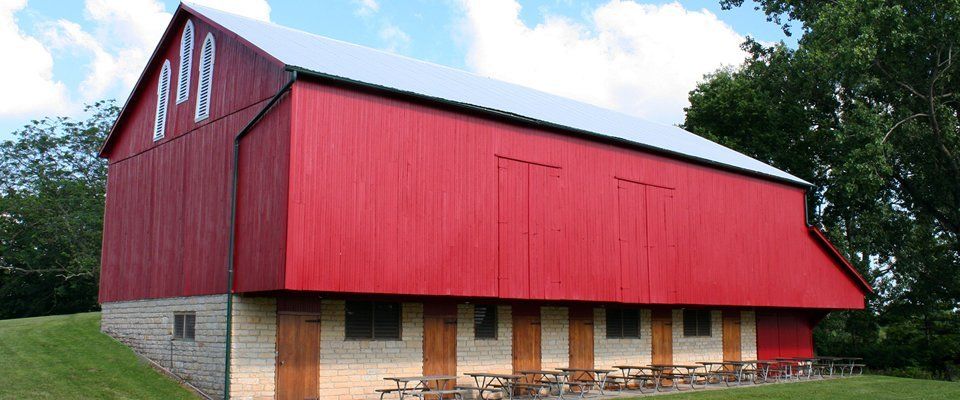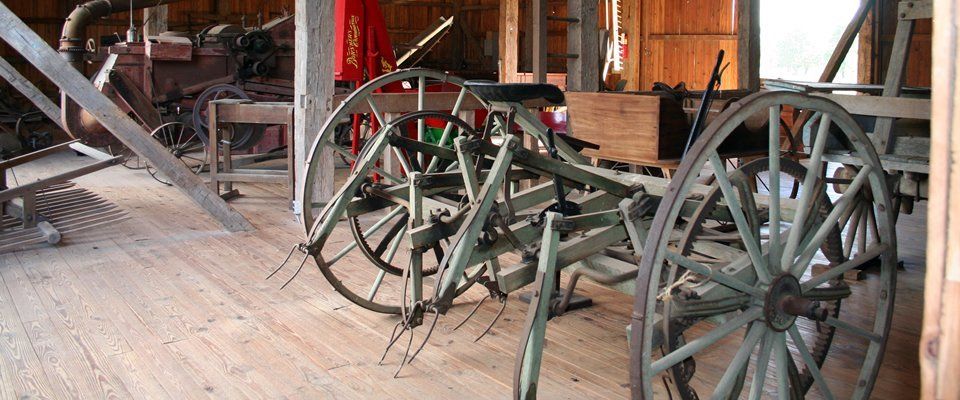Pioneer Barn - 6924 Brown Rd., Oxford OH
Open 12-4 Sundays, Memorial Day through Labor Day, or by appointment. We feature interns in living history who provide first-person interpretation of the site.
The present barn is not an original fixture of the Doty Homestead, but it is an authentic representation of the period. A big red barn was on the property when the Ohio Department of Parks and Recreation turned the Doty Homestead over to the Oxford Museum Association. Through the generosity of many friends who searched out their own barns and storage spaces, that barn became filled with relics of frontier country life. The Oxford Museum Association even had expanded it by building an addition to accommodate farm machinery of the early 1900′s. The old barn was a collection of collections, including: aged carpentry tools, most of a blacksmith shop, harness, some buggies and wagons, and numerous plows. The collection also contained, Indian relics, several guns and swords, a tractor, a threshing machine, even such curiosities as a hollow-log grain bin, a doll carriage, a cream separator, and a quaint shower stall.
On the night of July 11, 1980, a biker raced to a nearby farmhouse to report that the museum barn was aflame. Before equipment could arrive from the park and from town, the barn was gone. So was everything in it except a few iron articles and most of them were hopelessly twisted…useless, no longer authentic examples of anything except the effects of intense heat. Conversations about ways to replace the museum barn were begun almost immediately and the decision evolved to move another pioneer barn to the site, if possible, rather than construct a new barn.
The present barn is a relocated structure believed to be of 1840′s vintage. The Parks and Recreation Division of the Ohio Department of Natural Resources offered the Museum Association its pick of old barns scheduled for destruction at the undeveloped Sycamore State Park tract near Trotwood, Ohio. The barn selected was dismantled, its members tagged, and reassembled here, with such modifications as would be necessary to serve museum displaypurposes. It demonstrates the old-time method of fitting hand- hewn timbers with mortise-and- tenon joints, all handmade and secured with the wooden pegs called trunnels, as in “tree nails”.
When this barn was built, the builders used whatever wood was at hand in forests including beech, oak, cherry, ash, hickory, walnut and poplar. Consequently, It was reasoned that the barn restoration also could use whatever was at hand. Some wood came from timber felled in clearing a valley to create Acton Lake and stored by the Hueston Woods Park for some thirty years. The new barn exhibits some cherry framing and some beautiful walnut in the lower-level doors, which are replacements, and in the stairway, a modern concession to museum visitors.
The structure is known as a “Pennsylvania Barn”, also called a “bank barn” because of the earthen ramp providing second-level access for wagons and other farm equipment. It was a dairy barn through most of its life. Veteran farmers have been quick to suggest that the barn has been set a quarter-turn out of phase; it should be facing south, giving the warmest exposure to the overhang and stall doors.
The Pioneer Barn is owned by the State of Ohio but managed under lease by the Oxford Museum Association. The Hueston Woods Park and the Oxford Museum Association share maintenance responsibility.


